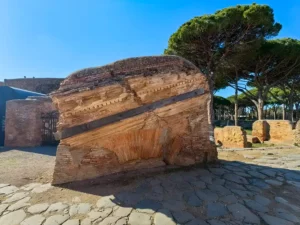The journey from the centre of Rome is easier than it seems. Take the metro to Pyramida station, where you change for a train that will take you directly to Ostia Antica for the same fare. Trains run up and down every half hour. The journey is at most 30 km. Ostia Antica: get lost in a city dead for a thousand years.

Ostia Antica, the first Roman colony
In Roman times, the town was situated on the coast and had direct access to the sea. The Romans could not have failed to notice this. The city once enjoyed great prosperity thanks to its harbour at the mouth of the sea and the Tiber River. At its best, Rome’s extended harbour had over 100,000 citizens who enjoyed great prosperity and tolerance.
There were several baths and a commercial pier around the dominant theatre, town hall, administrative buildings and squares. Magnificent villas, a military fortress (Castrum) and temples. Alongside the Roman ones, there were Christian churches and a Jewish synagogue. One can only admire how different people and ideologies coexist and prosper. We in Slovakia cannot do that even after two thousand years.



Via della Foce
The oldest structure discovered so far in Ostia Antica is a road that started at the mouth of the Tiber and went to Rome. It was built six centuries before Christ. It is, therefore, older than the Via Appia itself. Archaeologists refer to this road as the Via della Foce (meaning “Way of the Mouth”)
‘Ostia’ (the plural of ‘ostium’) is derived from the Latin ‘os’, meaning ‘mouth’. “The ‘mouth’ here refers to the mouth of the Tiber River, where Ostia was located.


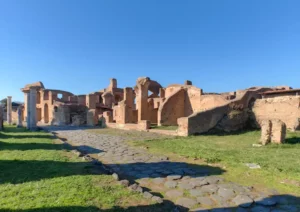
Lost Ostia Antica
Around 3. century AD, Ostia began to decline, supposedly due to flooding and silting of the sea, which pushed the city up to 3 km inland, making it no longer a port. The decline was gradual, and the last inhabitants left Ostia Antica during the 9th century after pirate raids.
Ostia ended up abandoned and forgotten for centuries. During the Middle Ages and the Renaissance, the ruins of Ostia were richly recycled. 🙂 The locals used to dismantle building materials and sculptural marble here. Apparently, it was cheaper than buying it. Ostia marble can thus be found in the cathedrals of such cities as Pisa, Florence, Amalfi and Orvieto. During the Renaissance, Ostia marble was used for statues.

Despite this, Ostia Antica has mainly remained undisturbed. It was only rediscovered in the 19th century when it was gradually transformed into today’s archaeological park. The ruins of Ostia Antica are considered by archaeologists to be a more significant testimony to the life of a Roman city than Pompeii.
Taking a trip to see the treasures of Ostia Antica, a dead city that, moreover, most tourists of Rome don’t even know, I consider the best idea in crowded Rome.



Just you and Ostia
No hints, walking in two-steps, guidelines or guides. No shouting, selling, music, bullshit, nothing… Not even a buffet. Just the quiet rustle of the wind in the tree branches, the azure overhead and the birds chirping.
In a few hours in Ostia we met about ten people. Not that there weren’t more, but in that huge space, in those alleys and mazes, you feel kind of lost.



Easy to get lost
When you enter Ostia, the city gradually engulfs you. No small museum. It’s easy to get lost in the hundreds of alleys and passageways.
“Johny doesn’t move away, or we won’t find each other”, I shout for the umpteenth time to Johny, who has fallen into photo-mania and is clicking his thousandth photo. We have God’s light. He forgets that his biggest weakness is his orientation in the terrain.

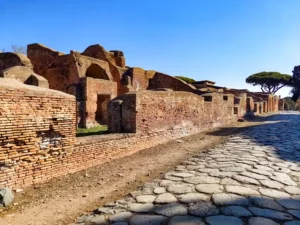
Ostia attracts us gradually
It is gorgeous at sunset. Walking through the streets, you start to have a mental conversation with the ancient philosophers. They, too, indulged in harlots, baths, bakeries, feasts, culture and also went to the toilet.
One of the prestigious tasks of slaves was to sit on the latrine until the master arrived. Do you know why? The slabs were stone and, therefore, cold. They had to be preheated and watered with running water.

Sitting on a two-thousand-year-old latrine, I wonder how many people have sat here before me. Masters and slaves, Romans, Christians, Jews and plebeians. How many people and how many lives, hopes and disappointments, happiness and bondage have passed through the walls of this city for more than two millennia. So many trails, joys and humiliations have they endured? How many people have been born and ended up in Ostia. Where are they? And where are we? What are we playing at? In the context of history and the feelings of that latrine, we are but a small fraction, a temporal junk.
The words of Paolo Demitra come to mind, “Life is too short not to make each other happy.” The inscription on an early Christian church on the Via Appia is “Quo Vadis Domine.” And where are we, inside the social nets, going after two millennia?
“It is not true that we have little time. The truth is that we waste a lot of it.” Seneca once said and added, “It is useless to ask whether life has meaning or not. It has the meaning we give it.”
Forum Baths


Castrum
Visiting the archaeological site of Ostia Antica is definitely like taking a step back in time. The oldest settlement discovered in Ostia Antica is the so-called Castrum. It was a rectangular military fortress with walls made of colossal tufa blocks. Based on historical events, it is believed that the Castrum was built as early as three centuries before Christ.
There are also five-storey buildings built before Slovak towns ever discovered masonry buildings. That is when the dimension of Roman civilisation dawns on man.


It is said that all roads lead to Rome
It’s not true. Most of Ostia’s paths and alleys lead nowhere or to another dead end. Elevated terraces and lookout points occasionally help you get your bearings.
“Where are you based?”
“Heeeereee.”
“Wheeeere heeeere?”
It’s one of the few good ways to find a stray friend. Even if only by voice.



Built city
As a person from Slovakia, it’s hard for me to admit that two millennia ago, they already had paved roads everywhere and sidewalks around the houses. Moreover, they were made in such a way that many have survived to this day.

Ostians knew how to live
Roman cities are cities of baths and temples. There are around 900 churches in Rome, which rises to almost 1,600 if chapels are included. In Ostia Antica it was no different.
At the beginning of the route, we tried to identify some. But gradually, we ended up like we were viewing a gallery in the Louvre. We began to see them as outdoor wallpaper. We were intrigued by the Temple of Aphrodite, the statue of Eros 🙂 what they were probably invoking in that temple, and also the fallen baptismal font by the remains of a Christian basilica.
If you’re interested in more, you can find it all here.

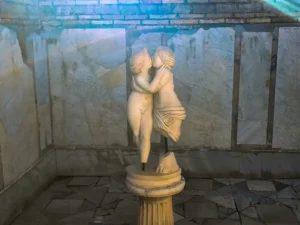

Ostia Antica
The unprecedented tranquillity of this place is occasionally disturbed by the local public address system. Mostly someone is lost. Local bedecked books tell you to spend at least three hours exploring. We spent a whole day in Ostia, and it was barely enough. We didn’t even make it to the local castle and museum.
More than the history, it was the atmosphere that captivated us. You can walk for miles. We pedalled almost 28K steps. Luckily the weather worked out. And the evening light…



A visit to Ostia Antica along the Via Appia would be the highlight of our visit to Rome. Nothing against the Colosseum and the Forum Romanum, but the very centre of Rome, with its crowds, shouting and chaos, will give you no space for yourself and your own thoughts.

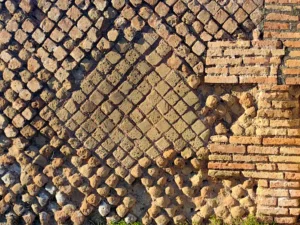

I have visited dozens of museums and lapidaries. When elsewhere they display a column, a statue or a fragment of a head, here you walk on them. They are everywhere. The size and reach of this place is gigantic.
This is the place if you want to explore antiquity while having peace, space and time to yourself. Ostia Antica: the archaeological park offers one of the most complete open-air monuments of antiquity. Plus, every Sunday, they have free admission.

